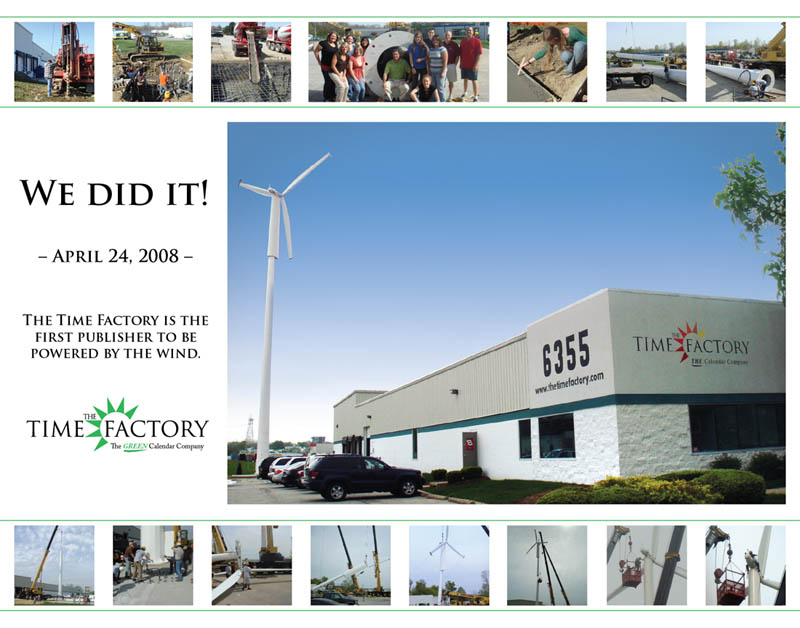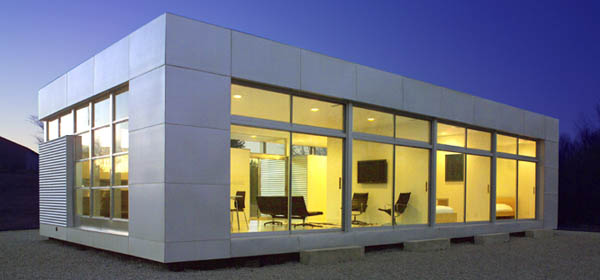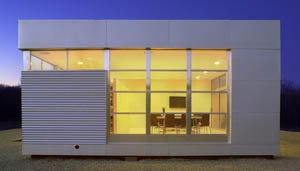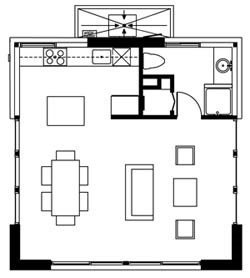 One of the most interesting stories to come out of the first WIndiana wind conference this week was the story of the Time Factory wind turbine installation in an industrial park on the northwest side of Indianapolis.
One of the most interesting stories to come out of the first WIndiana wind conference this week was the story of the Time Factory wind turbine installation in an industrial park on the northwest side of Indianapolis. Saturday, June 21, 2008
Wind-Powered Manufacturing
 One of the most interesting stories to come out of the first WIndiana wind conference this week was the story of the Time Factory wind turbine installation in an industrial park on the northwest side of Indianapolis.
One of the most interesting stories to come out of the first WIndiana wind conference this week was the story of the Time Factory wind turbine installation in an industrial park on the northwest side of Indianapolis. Green, Affordable, Disaster-Resistant Kit Homes
 If you are looking to rebuild quickly after being flooded out or blown out by recent storms in the Midwest, you may want to have a look at LV Series Homes by Rocio Romero that can withstand 150-mile-per-hour winds and have about twice the insulation of a standard home.
If you are looking to rebuild quickly after being flooded out or blown out by recent storms in the Midwest, you may want to have a look at LV Series Homes by Rocio Romero that can withstand 150-mile-per-hour winds and have about twice the insulation of a standard home. 

Wednesday, June 18, 2008
WIndiana 2008 - Day 2
Day 2 of Indiana's first WIndiana wind conference (see previous post for Day 1) began with a panel of utility company representatives talking about the opportunities and obstacles presented by wind power. Panel members included David Ziegner Commissioner of the Indiana Utility Regulatory Commission, Greg Wagoner representing Wabash Valley Power, Larry Brown of the Indiana Municipal Power Agency, Marc E. Lewis, Indiana Michigan Power Company, Diane Jenner of Duke Energy and Richard Benedict of Indianapolis Power and Light.
Larry Fowler pointed out that wind energy was not on the Indiana radar ten years ago when a remark was made at an energy conference that "wind opportunities in Indiana are negligible." He also noted that when Fowler Ridge Wind Farm is completed, Indiana will find itself among the top 15 wind states in the country. Some common themes among the panel members were that wind is something they are investing in to diversify their portfolios and hedge against the potential for carbon legislation or a national or state Renewable Portfolio Standard (found in 26 states, but not in Indiana). All expressed some concerns for greater implementation of wind power:
- predominantly off-peak power, not mid-summer hot afternoon
- intermittant power with 15% to 30% capacity factor (rated production not available all the time)
- the transmission infrastructure is outdated and not designed to handle new power resources and there's a long queue to get new projects on the grid
- the alternative energy Production Tax Credit expires at the end of 2008 and a predictable tax credit environment is necessary to make investment more attractive
- uncertainty over carbon legislation; most favored Federal legislation to set the rules of the game as soon as possible so companies could plan their future in a carbon-constrained world, which most agreed was inevitable
Rising costs are also inevitable according to many of the panelists for wind and for fossil fuels due to rising global demand for fuels and resources needed to manufacture plants, turbines and wiring. With carbon legislation and stricter emissions controls looming, Greg Wagoner of Wabash Valley said predictions of electric power price increases by industry experts ranged from 30% to 150%.
Duke Energy's Diane Jenner listed Energy Effciency as their "fifth fuel" after coal, gas, nuclear and renewables.
I spent the rest of the morning listening to the other end of the wind power spectrum, small wind (typically systems under 100 kW) that run on the other side of the electric meter. Another track at the conference explored opportunities for Indiana manufacturers to get into the wind business.
With small wind systems, you can create your own wind power plant for your home, farm or business. More on that in the next blog, including the story of the Time Factory, a small business in Indianapolis with it's own wind turbine and how it will have a 7-year payback with a little help from the Economic Stimulus Act of 2008.
This first WIndiana conference appeared to be a successful and well-run venture with over 300 attendees.
(See also previous post on Hybrid Power for Your Home)
Tuesday, June 17, 2008
WIndiana 2008 - Day 1
A packed house listened this morning at the first WIndiana wind energy conference at the Indianapolis Convention Center as Lieutenant Governor Becky Skillman ran the numbers. Indiana now has 130 MW of wind power in place (up from 0 at the beginning of the year), and will have 530 MW (enough to power 132,500 homes) by the end of this year. She also noted that 2500 MW of new wind is in planning in 15 counties in Indiana. According to Wind Powering America, each 1000MW of wind power has a $1.3 billion economic impact on Indiana.
This represents a major step away from Indiana's almost total dependency on coal. While Indiana gets 96% of it's electric power from coal, the national average is 50%. This places Indiana in a precarious position as coal prices rise due to international demand, a carbon tax or cap and trade system, and tighter emission controls phase in. Dirt cheap coal-fired electricity is about to go the way of $2.50 gas, and that may not be all bad for the Hoosier state.
Unlike coal-fired power plants, wind farms emit no sulfur dioxide or nitrous oxide or particulates or mercury or carbon dioxide and they don't require cooling water. Indiana has a wealth of free wind and an excellent transmission grid connected to major markets in other states. According to Larry Flowers of the National Renewable Energy Laboratory, new wind power is cheaper than new coal powered electricity. You can view the presentation he gave this morning here. Wind is an intermittant resource and it will never replace all coal plants, but it can be a substantial portion of a renewable energy portfolio along with solar, biomass and other renewables. Indiana will play a key role in the national goal of 20% wind energy by 2030.
Day 2 of WIndiana 2008 will feature the major utility companies' take on the situation. The second half of the morning will feature two tracks: one for Indiana manufacturers wishing to learn how to get into the business of manufacturing the giant turbines and another for small wind systems suitable for small businesses or homes. The conference will conclude with tours of big wind and small wind installations.
Monday, June 16, 2008
The Six Sins of Greenwashing
Sunday, June 8, 2008
Indiana: Crossroads of Supercells - Our Future?
 You probably thought that I had a case of carpel tunnel syndrome after my last lengthy post; The Cubic Mile of Oil, since I have been absent for so long. Unfortunately, nearly all my waking hours since then have revolved around recovering from supercell thunderstorms that have been raking the Midwest. And I have had it easy compared to other Hoosiers.
You probably thought that I had a case of carpel tunnel syndrome after my last lengthy post; The Cubic Mile of Oil, since I have been absent for so long. Unfortunately, nearly all my waking hours since then have revolved around recovering from supercell thunderstorms that have been raking the Midwest. And I have had it easy compared to other Hoosiers.